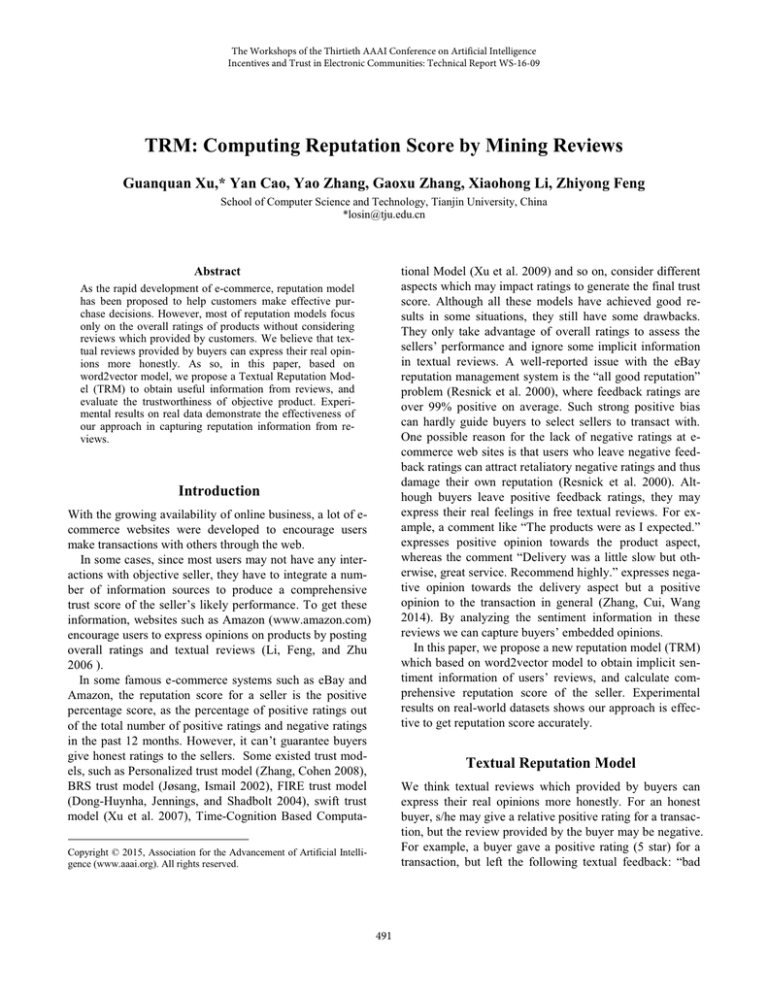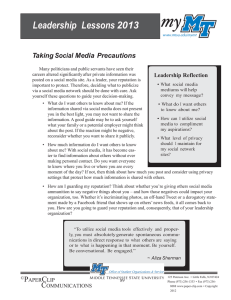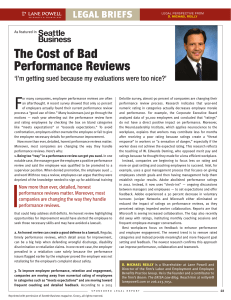
The Workshops of the Thirtieth AAAI Conference on Artificial Intelligence
Incentives and Trust in Electronic Communities: Technical Report WS-16-09
TRM: Computing Reputation Score by Mining Reviews
Guanquan Xu,* Yan Cao, Yao Zhang, Gaoxu Zhang, Xiaohong Li, Zhiyong Feng
School of Computer Science and Technology, Tianjin University, China
*losin@tju.edu.cn
Abstract
tional Model (Xu et al. 2009) and so on, consider different
aspects which may impact ratings to generate the final trust
score. Although all these models have achieved good results in some situations, they still have some drawbacks.
They only take advantage of overall ratings to assess the
sellers’ performance and ignore some implicit information
in textual reviews. A well-reported issue with the eBay
reputation management system is the “all good reputation”
problem (Resnick et al. 2000), where feedback ratings are
over 99% positive on average. Such strong positive bias
can hardly guide buyers to select sellers to transact with.
One possible reason for the lack of negative ratings at ecommerce web sites is that users who leave negative feedback ratings can attract retaliatory negative ratings and thus
damage their own reputation (Resnick et al. 2000). Although buyers leave positive feedback ratings, they may
express their real feelings in free textual reviews. For example, a comment like “The products were as I expected.”
expresses positive opinion towards the product aspect,
whereas the comment “Delivery was a little slow but otherwise, great service. Recommend highly.” expresses negative opinion towards the delivery aspect but a positive
opinion to the transaction in general (Zhang, Cui, Wang
2014). By analyzing the sentiment information in these
reviews we can capture buyers’ embedded opinions.
In this paper, we propose a new reputation model (TRM)
which based on word2vector model to obtain implicit sentiment information of users’ reviews, and calculate comprehensive reputation score of the seller. Experimental
results on real-world datasets shows our approach is effective to get reputation score accurately.
As the rapid development of e-commerce, reputation model
has been proposed to help customers make effective purchase decisions. However, most of reputation models focus
only on the overall ratings of products without considering
reviews which provided by customers. We believe that textual reviews provided by buyers can express their real opinions more honestly. As so, in this paper, based on
word2vector model, we propose a Textual Reputation Model (TRM) to obtain useful information from reviews, and
evaluate the trustworthiness of objective product. Experimental results on real data demonstrate the effectiveness of
our approach in capturing reputation information from reviews.
Introduction
With the growing availability of online business, a lot of ecommerce websites were developed to encourage users
make transactions with others through the web.
In some cases, since most users may not have any interactions with objective seller, they have to integrate a number of information sources to produce a comprehensive
trust score of the seller’s likely performance. To get these
information, websites such as Amazon (www.amazon.com)
encourage users to express opinions on products by posting
overall ratings and textual reviews (Li, Feng, and Zhu
2006 ).
In some famous e-commerce systems such as eBay and
Amazon, the reputation score for a seller is the positive
percentage score, as the percentage of positive ratings out
of the total number of positive ratings and negative ratings
in the past 12 months. However, it can’t guarantee buyers
give honest ratings to the sellers. Some existed trust models, such as Personalized trust model (Zhang, Cohen 2008),
BRS trust model (Jøsang, Ismail 2002), FIRE trust model
(Dong-Huynha, Jennings, and Shadbolt 2004), swift trust
model (Xu et al. 2007), Time-Cognition Based Computa-
Textual Reputation Model
We think textual reviews which provided by buyers can
express their real opinions more honestly. For an honest
buyer, s/he may give a relative positive rating for a transaction, but the review provided by the buyer may be negative.
For example, a buyer gave a positive rating (5 star) for a
transaction, but left the following textual feedback: “bad
Copyright © 2015, Association for the Advancement of Artificial Intelligence (www.aaai.org). All rights reserved.
491
communication, will not buy from again. Super slow
ship(ping). Item as described. ” (Zhang, Cui, Wang 2014).
Therefore, for an honest buyer, based on his review, we
can get his real overall rating.
Textual reputation model can be described as Figure 1.
gram architectures for computing vector representations of
word. For a certain word, through calculating the information distance between aspect keywords with it, we can
get the most relevant keywords.
In this paper, we delete the stop words and punctuations
to generate the text corpus. The word2vec tool takes the
text corpus as input and produces the word vectors as output. It first constructs a vocabulary from the training text
data and then learns vector representation of words.
Then for each aspect Ai , we gave some pre-defined
keywords wAi . For example, in a review about hotel, the
keywords about service contains “service”, about room
feature contains “room” and so on.
After that, for a sentence’s semantic word representation
xm ! {w1 , w2 ,...,wn } , we calculate the information distance
between word wn with different keywords by using cosine
similarity. Then, we can get the correlation between the
sentence and aspects by counting the words similarity, and
rank it to assign the sentence an aspect label.
For example, supposing a sentence’s word representation is xm ! {w1, w2 ,...,wn } , the correlation between the sentence and aspects is correlatio n( xm , Ai ) ! "nk !1 cosine(wk , wAi ) .
Then the aspect label of max(correlation( xm , Ai )) is the sentence’s aspect it belongs.
Textual
Reviews
Textual
Pretreatment
Aspect
Segmentation
Aspect Rating
Score
Computing
Aspect Weight
Overall Rating
Calculation
Seller Reputation
Score Evaluation
Figure 1: Textual Reputation Model.
For textual reviews, pretreatment is the first step. After
that, every sentence was divided into different aspect. Aspect rating scores together with their weights are further
computed by sentence sentiment. After aggregating the
results got from aforementioned steps, the seller’s reputation score can be calculated.
Overall Rating Calculation
In this phase, we take advantage of aforementioned results
to calculate the buyer’s overall rating. Note that a review
may not cover all the aspects about a product. It is possible
for a buyer to focus on only one aspect. In this situation, it
means that the buyer pay more attention to the aspect
which he is interested in. And this aspect must have a great
influence on the overall rating about the product. Therefore,
the weights of aspects should have associate with the number of sentences which belong to them. Otherwise, to calculate the aspect trust score, the sentiment of sentence
should be considered.
Since sentiment analysis is not the crucial part in our
model, we assign the sentences sentiment labels manually.
For example, “I felt very welcome at La Tortuga, and
very much liked that it was close to everything. Breakfast
and WiFi Internet access were included in the price. My
room was just OK, considering the room rate. The room
was clean, the air conditioning worked, there was enough
hot water, and the bathroom amenities were good. The bed
was too soft for my liking, but that's a matter of personal
taste.”, in this review, the numbers of sentences belong to
different aspects are shown in Table 1.
Textual Pretreatment
Since every review may contain a number of sentences and
each sentence may belong to a different aspect, it is necessary to pretreatment these reviews. Therefore, for a buyer’s
review D , we can get some sentences X ! {x1 , x2 ,..., xm } .
Then we delete the stop words in each sentence by using a
stop words list to get the sentence’s semantic word representation xm ! {w1 , w2 ,...,wn } .
Aspects Segmentation
For a general buyer, he may express his opinions about a
certain product from different aspects. For example,
Āprice”, “screen”, “lens”, ... , are all important features of
a digital camera. Hotel features include “price”, “room”,
“service”, and so on (Long et al. 2010, 2014). In this phase,
we map the sentences in a review into subsets corresponding to each aspect.
Since every aspect is associated with a few keywords,
we design an approach to map these sentences by using
word2vector model.
Word2vector (Mikolov et al. 2013a) (Mikolov et al.
2013b) is a learning tool which provides an efficient implementation of the continuous bag-of-words and skip-
Aspect
Number
Pos/neg
Location
1
1/0
Service
1
1/0
Room
3
2/1
Table 1: Results for Aspects Segmentation
492
For each aspect, we assume the number of positive sentence is Aipos , negative is Aineg . Then the rating value in
aspect i can be calculated by Equation 1.
Aipos
Aipos # Aineg
TA !
i
pˆ !
i
1
1 # a * (e $b*Number )
T!
(2)
d
"i!1TA *WA
(maxrating $ min rating ) # min rating
d
"i!1WA
i
i
Extensive experiments on one hotel review (TripAdvisor
dataset) were used to evaluate effectiveness of our Textual
reputation model.
Seller Reputation Score Evaluation
Following the definition of reputation by (Jøsang, Ismail
2007), the reputation score for a seller is the probability
that buyers expect the seller to carry out transactions satisfactorily (Zhang, Cui, Wang 2014). The reputation score
can be estimated from the positive and negative ratings
towards the product.
Based on Bayes rule, the expectation can be estimated
from observations and some prior probability assumption.
Γ(α # β ) ( α$1)
p (1 $ p)( β $1)
Γ( α ) Γ( β )
Dataset
The TripAdvisor dataset was originally used by Wang et al.
(2010, 2011). The dataset contains 246,399 hotel reviews
as well as overall ratings. Since some reviews consist of
few words, we select some suite reviews for case studies.
Case Study
In this section, we select some reviews from dataset randomly to verify the effectiveness of our model.
For the logistic function, we set a ! 1, b ! 20 , and The
results are shown in Table 2.
According to the results, we can see that our model can
predict the ratings effectively.
(3)
The Bayes estimate of S can be calculated as follows:
UserName
Location
Room
Service
Rating
UserName
TextTrust
Real
Value
UserName
TextTrust
Real
Value
EgyptTravelers
pos
neg
3
2
1
1
1
0
3.4657
(5)
Experiments
(3)
i
Beta( p | α, β ) !
"Uu!1 Ratingu # k
U * max rating # 2k
Note that, the U is the number of reviews, and the k is
the preset value to smooth the reputation value.
And the overall rating of a buyer can be calculated
as :
Ratingu !
(4)
Note that the Beta distribution is a special case of the
Dirichlet distribution for two dimensions (Heinrich 2005).
In BRS trust model (Jøsang, Ismail 2002), it adopts constant setting α ! α # 1, β ! β # 1 to get reputation value. However, it is not suit to the condition with a great number of
ratings. Inspired by CommTrust (Zhang, Cui, Wang 2014),
it can set α ! α # k , β ! β # k to be a suitable preset value.
Then the reputation score of seller can be calculated by:
(1)
Then we can get the rating of location is 1, the rating of
service is 1 and the room’s rating is 2/3.
Since the number of sentences in most reviews is less
than 10, we use the logistic function to smooth the weights.
And the weights is given by :
WA !
α
α# β
WA
i
0.8812
0.2698
0.1197
bluevoter
3.872
4.0
Philvincent
5.0
5.0
EgyptTravelers
3.4657
3.0
PepperR
3.333
3.0
Jeff P
2.095
3.0
Olliebuba
2.668
3.0
Conclusion and Future Work
This paper proposed a novel word2vector-based model to
obtain useful information from reviews. It can deal with
generate reputation score according to buyers’ textual reviews. Case study results on real data demonstrate the effectiveness of our approach in capturing trust information
from reviews.
In the future, we will use more datasets to verify it, and
we will also make some necessary adjustments to this
model to improve its accuracy and efficiency.
Sentiment analysis is another factor which should be
considered. It would be interesting to further explore Textual reputation model in such a setting where calculating
reputation score according to textual reviews.
Table 2: Results for Case Study
493
Based Computational Model for Trust Dynamics, S. Qing,
C.J. Mitchell, and G. Wang (Eds.): ICICS 2009, Beijing,
China, LNCS 5927, pp. 385–395.
Zhang, J., and Cohen, R. 2008. Evaluating the trustworthiness of advice about seller agents in e-marketplaces: A
personalized approach. Electronic Commerce Research
and Applications 7(3): 330-340.
Zhang, X.; Cui, L.; and Wang, Y. 2014. Commtrust: computing multi-dimensional trust by mining e-commerce
feedback comments. IEEE Transactions on Knowledge
and Data Engineering, 26(7): 1631-1643.
Zhuang, L.; Jing, F.; and Zhu X. 2006. Movie review mining and summarization. In Proceedings of the 15th ACM
international conference on Information and knowledge
management. ACM.
Acknowledgements
This work is supported by the National Natural Science
Foundation of China (No. 61340039, 61572355, 61572349)
and 985 funds of Tianjin University, Tianjin Research Program of Application Foundation and Advanced Technology under grant No. 15JCYBJC15700 and No.
14JCTPJC00517.
References
Dong-Huynha, T.; Jennings, N.; and Shadbolt, N. 2004.
FIRE: An integrated trust and reputation model for open
multi-agent systems. In Proceedings of the 16th European
Conference on Artificial Intelligence, August 22-27.
Heinrich, G. 2005. Parameter estimation for text analysis.
Technical report.
Jøsang, A., and Ismail, R. 2002. The beta reputation system. In Proceedings of the 15th bled electronic commerce
conference, pp 41-55.
Jøsang, A.; Ismail, R.; and Boyd, C. 2007. A survey of
trust and reputation systems for online service provision. Decision support systems, 43(2), 618-644.
Long, C.; Zhang, J.; Huang, M.; Zhu, X.; Li, M.; and Ma,
B. 2014. Estimating feature ratings through an effective
review selection approach. Knowledge and information
systems, 38(2), 419-446.
Long, C.; Zhang, J.; and Zhut, X. 2010. A review selection
approach for accurate feature rating estimation.
In Proceedings of the 23rd International Conference on
Computational Linguistics: Posters ,pp. 766-774, Association for Computational Linguistics.
Mikolov, T.; Chen, K.; Corrado, G.; and Dean, J. 2013a.
Efficient Estimation of Word Representations in Vector
Space. In Proceedings of Workshop at ICLR.
Mikolov, T.; Sutskever, I.; Chen, K.; Corrado, G.; and
Dean, J. 2013b. Distributed Representations of Words and
Phrases and their Compositionality. Advances in neural
information processing systems (NIPS).
Resnik, P. 2000. Reputation systems: Facilitating trust in
Internet interactions. Communications of the ACM, 43(12):
45-48.
Wang, H.; Lu, Y.; and Zhai, C. 2010. Latent aspect rating
analysis on review text data: a rating regression approach.
In Proceedings of the 16th ACM SIGKDD international
conference on Knowledge discovery and data mining , pp.
783-792, ACM.
Wang, H.; Lu, Y.; and Zhai, C. 2011. Latent aspect rating
analysis
without
aspect
keyword
supervision.
In Proceedings of the 17th ACM SIGKDD international
conference on Knowledge discovery and data mining, pp.
618-626, ACM.
Xu, G.Q.; Feng, Z.Y.; Wu, H.B. and Zhao, D.X. 2007.
Swift Trust in Virtual Temporary System: A Model Based
on Dempster-Shafer Theory of Belief Functions, International Journal of Electronic Commerce(IJEC), Vol. 12, No.
1, pp. 93-127.
Xu, G.Q.; Feng, Z.Y.; Li, X.H.; Wu, H.T.; Yu, Y.X.; Chen,
S.Z.; and Rao, G.Z. 2009. TSM-Trust: a Time-Cognition
494







